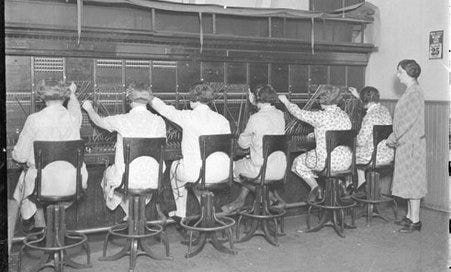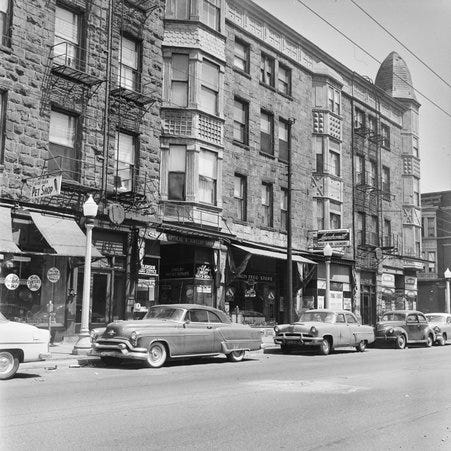Lately I’ve been bumping into the theme of how Hyde Park was a hub of correspondence and communications early in the 20th century.
When Hyde Park was a small village with a railroad passenger station at 53rd Street, it had its own post office near the station. When the Rosalie Villas opened along 57th Street with the villas stretching to 59th, 53rd Street seemed a long way away, so the pharmacist in the Rosalie Music Hall building set up a postal service. The praise for his initiative expressed by the Herald makes it sound like it was a surprisingly informal arrangement:
Quickly recognizing the pressing need of South Park for Post Office facilities, Mr. LeBrett with commendable enterprise has taken it upon himself to supply this want as far as possible and all who favor him with their names, may call and receive their mail matter which he collects promptly upon the arrival of the mails at the post office and all matter left with him, he assures us will be promptly posted. This, though causing him necessarily no little trouble, he is doing gratuitously, simply for the convenience of his neighbors and patrons.
By 1894, with the hotels and building boom boosting the population after the world’s fair, the post office moved into a much larger space, more centrally located in the expanded neighborhood. The building was known as the Post Office Block between Dorchester and Kenwood. It was built by Joseph Van Craenenbroeck a long-time Hyde Park resident. The Herald carefully noted that the building was fireproof.
It looks as though the building survived into urban renewal. At least, this photo from 1955 of the building in the 1300 block of 55th Street is how the building looked with the bays and turret in sketches made in the Inter Ocean in 1894. The post office was officially 1347 East 55th Street so it’s possible this is an extremely similar building on the other side of the street.
In 1894, the essential services provided by the post office were celebrated. As the Inter Ocean said, Hyde Park was “en Fete” celebrating its opening.
It was a daylong event. The parade began at the grand Illinois Central station at 57th Street, where many postal officials arrived and entered their open carriages to form a parade accompanied by a long line of letter carriers on bicycles and on foot. The parade route along 55th Street was decorated with flags and bunting while “crowds of pretty girls in smart summer gowns waved a welcome to the visiting officials.” The grand assembly entered the new post office, which was decorated with flowers and potted palms. Speeches were made and an orchestra played to whoever managed to squeeze into the space.
The guests retreated to a meal at the Windermere Hotel (the old one), where more speeches were made, until it was time for the banquet at the Vendome Hotel for 100 very important people. The tables formed a square and were decorated with roses, hyacinths, and smilax. The speeches continued until after midnight. It sounded like an endurance contest.
The Vendome Hotel was at 6200 S. Kenwood, built for the fair.
You might observe that the ad for the Vendome Hotel says Oglesby, not Kenwood. Well, that was the nightmare that the post office was enduring from 1889 to 1913. I mentioned it in the article about the Rosalie Villas. After the city annexed a number of suburbs, the post office was having to sort out multiple streets with the same name, different numbering conventions, and even single locations known by multiple numbers and names. It was a massive disorienting process to dictate a solution and people were not happy, but the result is Chicago’s orderly system of streets and numbers.
Even with it all straightened out so there was only one Monroe and Madison, sorting the mail before zip codes and automatic readers was hard. The Post Office put out a plea in 1928 that addresses should read “Hyde Park, Chicago, Illinois” for faster sorting. I imagine it helped keep local mail local. They expected mail to move quickly, especially when there were two deliveries a day. When the cable car system was running, mail sorting cars allowed for same day delivery in some locations. The mail cable car is one reason the American School of Correspondence set up shop close to the Cottage Grove cable car system, so they could put out the large sacks of mail for rapid delivery. The school’s Pond and Pond building is landmarked and still on 58th Street. It was a step back into another era to go into its dark dingy spaces. I was there as part of the ritual many grad students and residents went through of picking up spare change grading exams.
In 1927, 1,616,000 letters were handled by the Hyde Park Post Office with an additional large increase in special delivery and registered mail. The busiest day saw 254,000 letters go through the office.
The year 1927 was also the year that the manager of the local telephone exchange told a lunch of the Kiwanis Club that Hyde Park was the largest telephone exchange in the world. The first telephone exchange was at 5723 S. Dorchester where in 1902 the switchboard was 100 feet long.

Apparently the suggestion was made that the small shift of overnight workers should have roller skates to handle the 100 foot long switchboard but the idea was nixed as being too much fun for the operators. It had 50 employees, many of them women who were more reliable across a whole shift. By 1915, it had moved to the larger building at 6045 S. Kenwood (still standing) and employed hundreds of people. It particularly relied on women to connect the calls manually. They apparently had a better attention span and were less likely to argue with callers.
My theory is that the World’s Fair spurred the early use of phones in Hyde Park because so many hotels were built at the same time and so many wanted to offer the luxury of phones for their guests. Each hotel had its own switchboard. The guests traveled around the country and around the world, as noted in the society columns, and they had to keep in touch.
Even in the 1950s, when dial phones were taking over, Hyde Park was the largest exchange in Chicago, employing 500 people to keep 100,200 dial and nondial phones running.








Trish, I believe you will find if you check that the exchange by 60th and Dorchester was known as the Dorchester exchange - it was still referred to that way by the Ameritech/SBC/Illinois Bell technicians that I dealt with over the years. I can't tell you what the other exchanges serving Hyde Park and Kenwood would be...I know that here in Kenwood, my service comes through a central office switch somewhere farther north and west.
Fascinating!
A note on mail service: when I lived in Paris in 1977, a year when Hyde Park mail was being dumped into Lake Michigan, I got mail whenever it came in. One day I got mail 4 times!!